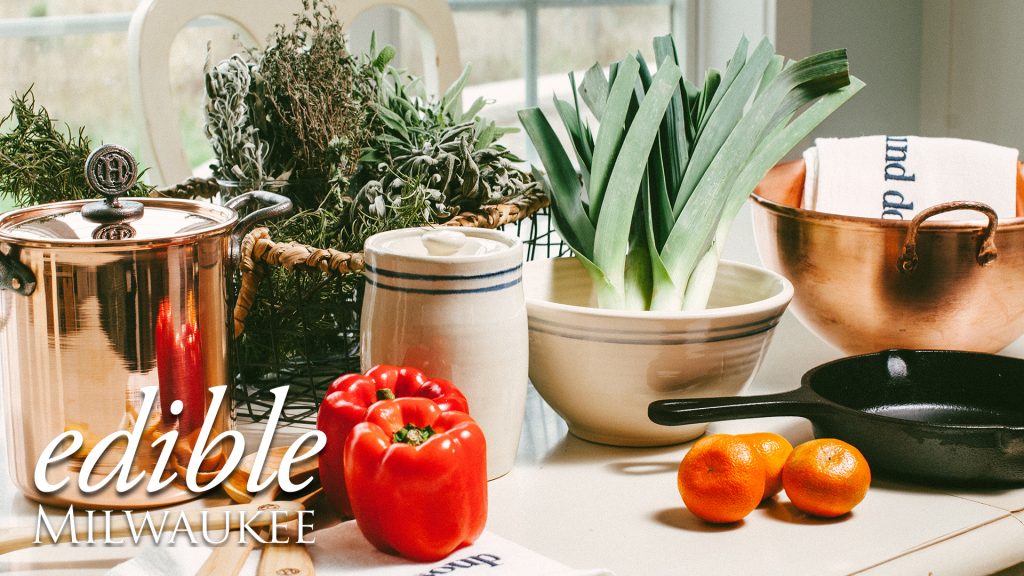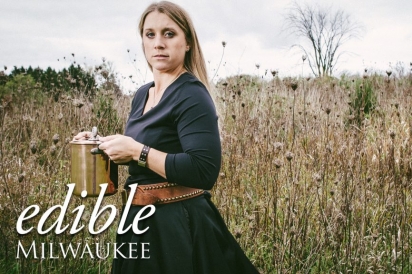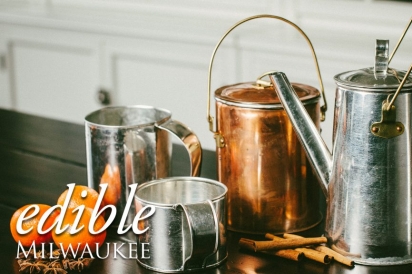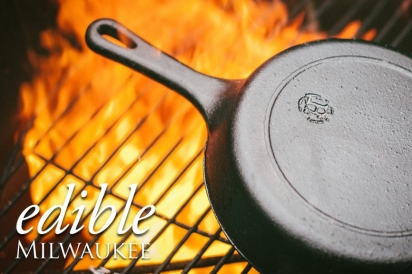Wisconsin-Made Kitchenware: The Base of Cooking Local
Wisconsin-Made Kitchenware
In 1939, the Aluminum Goods Manufacturing Company of Manitowoc tempted new brides with a 22-piece set of its finest cookware: “The grandest gift of all—(or the grandest equipment for your own kitchen)—is this new set of MIRRO—the Finest Aluminum.” Another ad promised women that they had “a right to feel self-satisfied when you know that a midnight raid on your kitchen will reveal, not disreputable old relics of pots and pans, but ware that’s Mirro-fine.” Beyond utility, cookware had become a status symbol.
We may not think much about the pots and pans in our cupboards, but the archaeological record is literally littered with kitchenware. It is these vessels and the changes in them archaeologists often use to mark the passage of time and changes in cultures. The same could be said of our own cookware.
“Cookware used to be handmade,” says Sara Dahmen, owner of Port Washington-based Housekeeper Crockery. “It was made to last a lifetime, maybe several lifetimes. That isn’t true anymore.”
Today, it’s easy to find a skillet made halfway around the world for less than $20. But in the 19th century, cookware was just as local as the food cooked within it. Skillets came hand-poured from a local iron foundry, pottery was molded from local clay, and saucepots were fashioned from locally forged copper. These artisans gradually gave way in the late 19th and early 20th centuries to mass produced cookware made of new materials like stainless steel and aluminum. Iron, which had set the standard for kitchenware since the mid- 1400s, was largely replaced with cookware that was decorative, lighter weight, less prone to rust and cheaper.
Aluminum, in particular, was instrumental in the development of the modern cookware industry. And it was an industry that took off in Wisconsin, particularly along Lake Michigan.
Although aluminum is one of the most abundant elements on earth, it wasn’t until the late 19th century that a viable process for mass commercial production was developed. The first mass produced aluminum items were novelties like combs and cigar cases.
Wisconsin-Made Goods Get Their Start
Joseph Koenig founded the first aluminum manufacturer in Wisconsin, the Aluminum Manufacturing Company in Two Rivers in 1895, after seeing an array of aluminum goods on display at the 1893 World’s Fair in Chicago. He spent the next two years perfecting his method and returned to Chicago in 1895 with combs, mustache cups and salt-and-pepper shakers, among other items. He received more orders in two hours than he could make in three months.
A few years later, Koenig merged his company with the Manitowoc Aluminum Novelty Company and the New Jersey Aluminum Company to become the Aluminum Goods Manufacturing Company. They began making cookware in 1913 and introduced the well-known Mirro line in 1917.
The success of the aluminum industry in Wisconsin was due in part to the decline in lumbering. As lumber camps disappeared in the late 19th century, Wisconsin had an abundance of laborers in need of the steady, year-round work that aluminum could provide.
Through door-to-door sales and cooking demonstrations, housewives came to prefer aluminum utensils in the 1910s. By the 1920s, Wisconsin produced more than half of the nation’s output of aluminum cookware. Five aluminum firms employed nearly 3,000 workers, one quarter of them women.
War strained the aluminum industry and threatened the cookware business as aluminum moved to the mandatory priority list. To stay afloat, companies like the West Bend Aluminum Company won government contracts to produce war material like anti-aircraft cartridges.
Wisconsin’s aluminum makers returned to consumer production after the war. They also diversified beyond aluminum to make products out of stainless steel, copper, plastic, and brass, and developed new products like the iconic Penguin Hot and Cold Server, a staple of cocktail parties in the 1950s.
Aluminum and other cookware continue to be made in Wisconsin. Regal Ware Inc., once the Kewaskum Aluminum Company, is still headquartered in Washington County.
But it was an older style of pots and pans, before aluminum, that interested Port Washington’s Sara Dahmen.
A Craft Crockery Renaissance
Dahmen had always loved to cook and bake but hadn’t given pots and pans any real thought until she wrote a historical novel featuring a widowed housekeeper in the Dakota Territories. That novel, Doctor Kinney’s Housekeeper, led Dahmen to explore old-fashioned craftsmanship.
“It was a slow evolution,” explains Dahmen. “I’ve always enjoyed history and pretending to live in historic times so telling the story of this housekeeper, Jane, made me obsessed with old cookware and the tools Jane would have used.”
It was this research that led Dahmen to the realization that much of the cookware common in the 19th century, the fictional Jane’s whole world, was missing from the modern kitchen. So she decided to make her own, launching a line of handcrafted items known as Housekeeper Crockery.
But first she had to find craftspeople that could make the kind of cookware she envisioned. Dahmen knew she wanted to work with small businesses, preferably those based in Wisconsin. Most of the copperware on the market today comes from China, India, Italy and France.
“No one has been mass producing copperware in the United States for decades,” says Dahmen. “There are small shops making very small amounts of wares.”
Many of the copper pots on the market today are too thin to conduct heat properly. Dahmen says the pots need to be at least 1.5 millimeters thick to do a good job. Any thinner and consumers are paying for the look rather than the benefits of copper.
Dahmen painstakingly pieced Wisconsin- and Midwest-based businesses together, finding people willing to relearn old methods and to experiment along with her.
“Everyone was so generous with their time and knowledge,” says Dahmen. “It was a painful process to take on something entirely new, but when I found the right people, everything clicked.”
Dahmen found a foundry in Kaukauna to pour her cast iron skillets. She reached out to potters at Rowe Pottery in Cambridge for her bowls and found a rivet maker in Markesan who could make the rivets for her copper cookware.
She worked with each company to design her historically inspired custom products, looking to old pots and pans as models for her cookware. Housekeeper Crockery pots are taller than the modern short and squat pots most us have in our cabinets, with handles reproduced from 1830s pot handles.
Her iron skillets come both raw and seasoned. She’d heard that many people stripped the seasoning off their skillets to start from scratch so she decided to offer skillets unseasoned and still silver. Her seasoned skillets are hand-seasoned with organic flax oil from North Dakota.
Talk with Dahmen may induce flashbacks to high school chemistry with her talk of conductivity, the benefits of non-ferrous metals, and coefficients of thermal expansion. Learning the science has helped Dahmen understand the common misconceptions about cookware.
“Many people think that copper needs to be paired with stainless steel, but that’s not true,” says Dahmen. “Stainless steel heats slower and is harder to control.”
Pure unalloyed copper, says Dahmen, conducts heat so well that it’s more efficient, using far less energy than other metals to achieve the same results. It also allows for quick increases and decreases in temperature.
Food also sticks to stainless steel. That’s why Dahmen lines her pots with tin, a naturally non-stick material that bonds at the molecular level with copper.
“They are both non-ferrous—they contain no iron—so they form a permanent bond and conduct heat together,” explains Dahmen.
Dahmen says she’s learned the lingo enough that she’s been asked more than once if she’s an engineer. “I really geek out on the science,” says Dahmen, laughing.
But as Dahmen moved forward with her business, she also found herself moving deeper into the past and her understanding of historical production methods. She discovered Bob Bartelme, a master tinsmith in West Bend, who invited her to come watch him work. His shop, says Dahmen, was like stepping back several centuries.
“He has all these old tools that he uses to recreate old kitchen ware,” describes Dahmen. “I just wanted to watch but then he invited me to try to make something, and, before I knew it, I’d become his apprentice.”
There are very few tinsmiths in Wisconsin, and Dahmen is eager to keep the trade alive. She now spends three to four hours per week learning from Bartelme.
Dahmen isn’t done learning or searching for new makers to partner with for her new old cookware. “I’m mildly obsessed with cookware and authentic, real goods that last,” she says.
So, What’s So Dutch About a Dutch Oven?
Cast iron cooking vessels have been used for centuries, but it was the Dutch who came up with a superior method for making them in the late 17th century. Using dry sand molds, the Dutch made a smoother, thick-walled pot. It’s that method rather than any particular cooking style that likely gave the Dutch part to its name. The “oven” comes from the lid that encloses the pot.
But it was an Englishman who popularized the Dutch oven and made the mass production of cast iron possible. In 1704, Abraham Darby traveled to the Netherlands to observe and study the casting process. Darby patented a similar process a few years later using reusable patterns and began making and selling cookware at his furnace in Coalbrookdale in England. More importantly, though, in his experimenting, Darby discovered that coke could be used as a substitute for charcoal to smelt iron, a discovery that fueled the Industrial Revolution.








